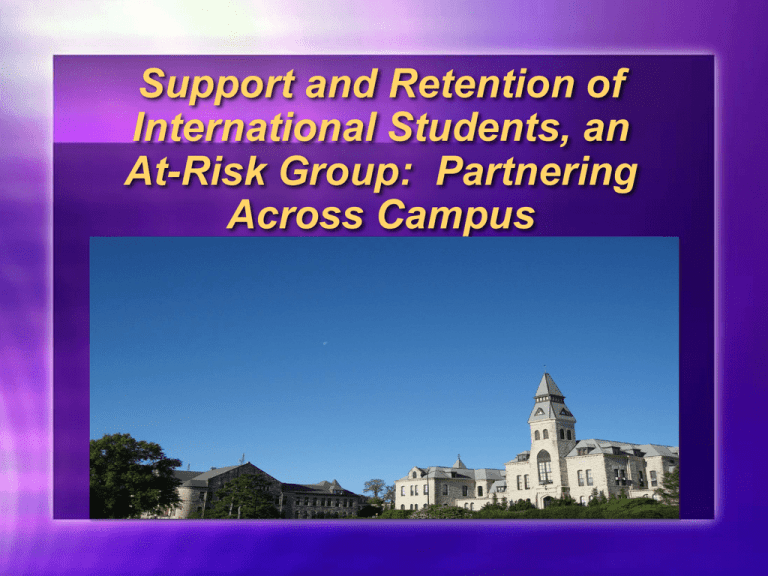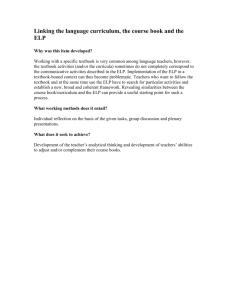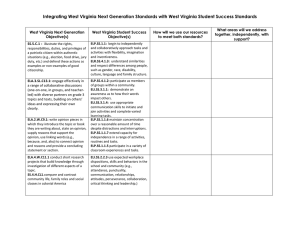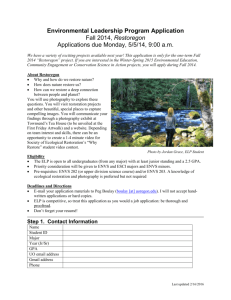Support and Retention of International Students, an At-Risk Group: Partnering Across Campus
advertisement

Support and Retention of International Students, an At-Risk Group: Partnering Across Campus http://www.epodunk.com/cgi-bin/genInfo.php?locIndex=4827 Kansas State University English Language Program Leena Chakrabarti, Assistant Director Adrienne Hamann, Student Services Coordinator Presentation Outline Research of international students as an at-risk group English Language Program Student Services - In House Advising - Partnerships Audience sharing ideas in small groups Q&A Research Why should International Students be considered as At-Risk Students? What defines an at risk student? Socio-economic status Unrealistic goals Adult returners after long hiatus Cultural barriers Language barriers Access to student support services Travel time and costs Weak self concept http://www.schoolcraft.edu/pdfs/cce/12.2.23-32.pdf 1. Performance “[…] International students are not achieving as well as their local counterparts, in fact are failing much more readily, seemingly because of lack of the requisite English language skills” (Paton, pg. 20). 2. Adaptation “International students come from a vast range of cultural and linguistic backgrounds. While it is easy to document the first language and country of origin of overseas students, what is not so obvious is the nature of their previous educational experience; in particular the culture of learning to which they were accustomed in their home countries” (Baird & Dooey, 2012, pg. 102, ) 3. Stress Management “In addition to adjusting to a new educational system and a new social environment, international students face unique sources of stress such as homesickness, culture shock, language barrier, financial difficulties, immigration requirements, racial discrimination, and strenuous academics (Xuesong Han, Xuemei Han, Luo, Jacobs, and Jean-Baptiste, 2013, pg. 1).” ELP History Growth of program: Number of students 1986 2005 2009 2015 38 70 485 297 Faculty: 2 full time and 2 part time in 1986 47 full time in 2015 Demographics Chinese and Saudi Ecuadorian and Brazilian (special programs) 80% of our students come admitted to the university 10% come for English only, then get admission 10% are on exchange or are spouses, etc. Laura Phillips-Zee Instructor/Advisor ELP Student Services Team Ellen Conroy Instructor/Advisor Anne Cannon Instructor/Advisor Brandy Caulfield Instructor/Advisor Adrienne Hamann Leena Chakrabarti Student Services Coordinator Simone Willert Assistant Director Office Manager In House Advising Orientation Classes Advising Appointments TOWARD class Social Hangout Awards Ceremony Orientation Class Rationale Both orientation classes are semester long courses Many programs provide a week-long orientation We have developed these two orientation classes to aide in the transition that students have to make when coming to the United States. Basic ELP Orientation High beginning through low intermediate international students Basic information such as ELP grading process and scheduling information ELP faculty present on plagiarism, motivation, and organizational skills. Student Worker Contribution Take attendance Assist students on an individual basis Individual lessons with students for makeup classes Presentations on sports in the USA and a digital library tour They build relationships with the students Student Workers (Contd) Jia Li: Mandarin, Malay, Cantonese China, Singapore, Cambodia, and Japan Julie: Portuguese Traveled to and studied in Brazil Putnam Scholarship, Kansas Music Scholarship Mauricio: Spanish Vice President of International Buddies Student Workers (Contd) Nick: Portuguese, Spanish Brazil, Philippines, study abroad in Australia Presidential award for study abroad Ronnie: Spanish Study abroad in Spain, Japan, and Taiwan, taught English in Mexico Truman Scholarship Nominee, Cargill Global Scholar, College of Agriculture Scholarships, McKelvie Public Service Scholarship ELP Student Services Orientation to Higher Education Emphasize cultural and academic understanding Develop effective academic and life skills Provide student-instructor and studentstudent interaction in English Orientation to Higher Education Cover an array of topics that students will need to understand while at KSU. Topics include: - GPA and grades - Academic Integrity - Legal Issues - Career Services - Stress Management - I-20s and Travel Travel Project for Orientation to Higher Education Students get into groups and sign up for a destination of their choice. Each person in the group is responsible for one of the following: - Travel (airfare and/or car rental) - Research (historical importance, facts, etc) - Places to see and things to do (monuments, sights, etc) - Food and hotel (find local restaurants) The PowerPoint is worth 20 points. The purpose of the project is to expose students to group work , money management, safety, and to practice citing sources. Advising Appointments Connected to Orientation classes Every new student at all levels meets with an advisor during their first semester They will meet with an advisor again in higher levels when they take upper level orientation Advising Appointments (contd.) Gather information about student’s well-being Early intervention Check on grades Offer support Each student will have a face in the ELP that they can relate to TOWARD Class for Reinstated Students Students who are reinstated have had three semesters of nonperformance Training in organization, wellness, academics, responsibility and discipline Twice a week, 2 credit hours, graded class Students from all levels (beginning to advanced) Taught at the ITC – individual computer access and printing work TOWARD - Organization Calendar –input test dates and major assignments Checking K-State Email Help students stay on track TOWARD - Wellness Physical/mental wellness - includes exercise classes and Social Hangout participation Visiting speaker from Lafene Health Center to talk about wellness topics such as importance of sleeping, medicines and vaccinations. TOWARD - Academics 24 study skills classes in a semester They are not learning anything new, but reviewing material Self-motivated students – general monitoring Less-motivated students – more supervision TOWARD – Responsibility & Discipline ACIC - Academic and Career Information Center – students do a StrengthsQuest assessment – matches your academics and interests to a career Group Challenge course at the Rec Center Responsibility to the group/team Social Hangout Meet once every two weeks for two hours Practice English in a social setting and opportunity for social involvement Make new friends Learn about American culture and the culture of classmates Started in Fall of 2013 Student worker participation Social Hangout Activities Awards Ceremony Faculty nominate students who they think show exceptional achievement in the ELP Winners are chosen from each level Certificates and gift bags are presented to the winners Awards Ceremony Contd. Associate Provost and directors of International Programs, provosts and deans from different colleges, and ELP faculty are invited to ceremony. We rent a large theatre hall in student union for this event. Partnerships University class audit – list of large lecture classes for students to visit Housing and Dining, Counseling Services, Office of Student Life and the Student Health Center Missing Student Protocol in tandem with the Office of Student Life Pre-enrollment – deans and student advisors to pre-enroll Group Activity Get into small groups Discuss one creative and successful thing that your program does for student support Share ideas with everyone Q&A http://www.k-state.edu/elp/professional_presentations/ Resources Baird, Craig & Patricia Dooey. Journal of the Australian & New Zealand Student Services Association; Apr2012, Issue 39, p9-20, 12p. Bulger, Stephanie & Debraha Watson. “Broadening the definition of at-risk students.” The Community College Enterprise. Fall 2006. Chickering, Arthur. “Arthur Chickering’s Seven Vectors of Development.” Education and Identity, San Francisco: Jossey-Bass. 1969. Gordon, Virginia N., Wesley R. Habley, & Thomas J. Grites and Associates. Academic Advising. Jossey-Bass A Wiley Imprint. 2008 Han, Xuemei, Xuesong Han, Selby Jacobs, Michael Jean-Baptiste, & Qianlai Luo. Journal of American College Health; Jan2013, Vol. 61 Issue 1, p1-8, 8p. Paton, Michael John. “Why International Students are at Greater Risk of Failure: An Inconvenient Truth.” The International Journal of Diversity in Organizations, Communities, and Nations. 2007. Volume 6, Number 6. Phinney, Jean S. “A Three State Model of Ethnic Identity Development.” State University of New York. 1993.


